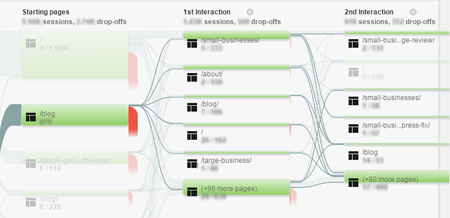 If you’re looking for new ways to optimize conversions on your site, customized reports from Google Analytics may be able to help.
If you’re looking for new ways to optimize conversions on your site, customized reports from Google Analytics may be able to help.
Running out of ideas to increase conversions? Google Analytics (GA) is your friend. But you have to know where to look. Using the standard “out of the box” configuration of GA will give you some great insights, but taking the time to do a little customization can unlock more data, more reports, and more ideas for optimization.
Segment and Target Lingerers
Google Analytics offers an incredible amount of behavioral data, which can be used to target those who visit your site repeatedly to browse but ultimately fail to take action. There are a host of possible reasons for this:
- Shipping. The costs might be too high.
- Product cost. Products may be available elsewhere cheaper.
- Buying cycle. Users may simply be in the research phase.
- Availability and findability. Users may not be finding what they are interested in.
You could take a wild guess about what’s going on with these visitors, or you can visualize the user flows to draw more accurate conclusions. Visitor flow reports within Google Analytics show where users enter your site, where they proceed from there, and finally where they leave. Use this data to see visitors where visitors are meandering off the main conversion path and to develop new ideas for optimizing the flow to ensure that visitors move more efficiently toward conversion.
Once these folks leave your site, use retargeting to lure them back. And, since you have a pretty good idea what they were looking at when they left, you can tailor your ads, landing pages, and offers around their specific interests.
Get to Know Your Spenders (As Well as Under-Purchasing Segments)
Analyzing average consumer spend is not generally very meaningful from an optimization standpoint. What you want to do is identify top-spending segments of visitors so you can better understand who they are and what’s important to them. This will allow you to optimize the experience for other visitors who have key characteristics in common with your high-spenders.
GA’s affinity trends help here because they show you the general interests and demographics of visiting consumers, in addition to the amount that they ultimately spend in relation to other visitors. You’ll need to take a few extra steps in your GA setup to enable the Demographics and Interests reports, as well as the Advertiser Features, to get your hands on this data, but the information can be useful in helping you identify and target under-purchasing market segments. Sports fanatics may be purchasing $5 less per consumer than television fanatics; the process of data analysis and testing can be used to uncover the source of the problem. Appealing to each market segment that offers traffic is critical to improving conversion overall: the traffic is already there, it simply needs to be optimized for.
Sessions, bounce rates, pages viewed, and transactions are all listed under affinity trends and can be used to create a more holistic portrait of your best (and worst) segments. If pet lovers are bouncing off the page at a higher rate than gamers, traffic sources and queries accessed through Google Analytics can be used to first identify what pet lovers are seeking and then to target the site and its relevant landing pages toward conversion. Tailored user flow reports can be used to further drill down to the behavior of the market segment.
Identify Shifting Trends
In order to continue growing, it’s not enough to simply understand your current audience; you also need to know how your audience is changing. If you have seen a decrease in conversion, it could be a momentary lapse or it could be a core change in audience. The demographics information combined with the % new sessions in Google Analytics will show you how your audience is shifting and the behavior of your new audience compared to the old. Creating a new market segment in Google Analytics will allow you to better track the conversion behavior of your new audience. You can also set alerts to trigger when new users are waning.
Data can be misleading if it is not investigated fully. Seeing younger users coming in and bouncing at higher rates than older users could mean that you need to target your landing pages appropriately toward them, but that’s a very basic analysis. A more detailed analysis might find instead that these newer users have certain platforms, such as mobile devices, in common. Thus, it may not be an actual lack of interest but instead a poor user experience that is leading to lower conversion rates. Google’s audience tracking services will reveal these patterns.
If you’ve tackled all the “big” conversion barriers on your site and you’re struggling to find ways to keep moving the needle, designing specific optimization strategies for narrow market segments can be an effective way to feed your optimization cycle. As the above tips show, looking at the data you already have in new ways may help you uncover opportunities that you might have overlooked previously.
___________________________________________________
This article originally appeared in Tim’s ClickZ column February 3, 2015


